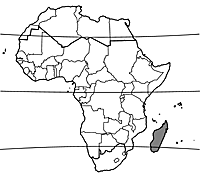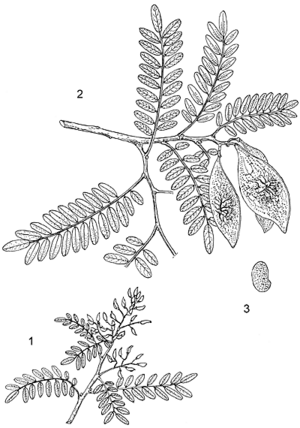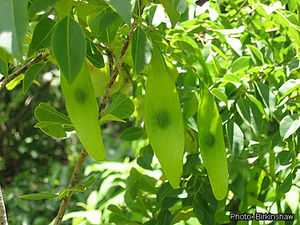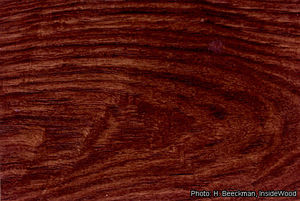Dalbergia baronii (PROTA)
Introduction |
| General importance | |
| Geographic coverage Africa | |
| Geographic coverage World | |
| Timber | |
| Ornamental | |
| Conservation status | |
Dalbergia baronii Baker
- Protologue: Journ. Linn. Soc., Bot. 21: 337 (1884).
- Family: Papilionaceae (Leguminosae - Papilionoideae, Fabaceae)
Vernacular names
- Voamboana, palissandre brun, palissandre de Madagascar, palissandre rouge des marais (Fr).
Origin and geographic distribution
Dalbergia baronii is endemic to eastern Madagascar. It has occasionally been planted elsewhere, e.g. in Tanzania.
Uses
The wood of Dalbergia baronii is usually not distinguished from that of some other Dalbergia species, notably Dalbergia monticola Bosser & R.Rabev. The latter was not distinguished from Dalbergia baronii until recently. The wood is one of the so-called rosewoods (‘Madagascar rosewood’, ‘palisander’), which are much in demand for cabinet making, furniture, marquetry and parquet flooring. It is one of the favoured woods for musical instruments, especially guitars, not only because of its beautiful colour and venation, but also because of its clearness of tone. It is also suitable for shingles, exterior and interior trim, joinery, carpentry and framing, ship and boat building, vehicle bodies, precision equipment, carvings, toys and novelties, turnery, pattern making, veneer and plywood. It is used for carving traditional art by the Mahafale people. In the past the wood was used exclusively for the construction of houses for royal people.
Production and international trade
The wood is still traded on the international market, usually in small amounts and at high prices, for special applications such as musical instruments. In recent years it has replaced Brazilian rosewood (from Dalbergia nigra (Vell.) Benth.) because this South-American species has been included in Appendix I of CITES as an endangered species. It is often traded as quarter-sawn pieces of comparatively small dimensions. In 1999 Madagascar officially exported about 1500 m³ of palisander from different Dalbergia spp., but according to other estimations about 3200 m³ was exported. Sculptures made of Dalbergia baronii wood are found on local art markets in Madagascar.
Properties
The wood of Dalbergia baronii is similar to that of Dalbergia monticola and the two are not distinguished in trade. The following description refers to both species. The heartwood is greyish yellow-brown to reddish brown or dark brown, often with darker stripes, and distinctly demarcated from the sapwood. The grain is generally straight, texture fine and even. Fresh wood has a sweetish smell.
The wood is moderately heavy to heavy, with a density of 620–950 kg/m³ at 12% moisture content. It air-dries satisfactorily but slowly; turned pieces used for precision equipment or musical instruments should be dried thoroughly to avoid later distortion. The rates of shrinkage are moderate, from green to oven dry about 4.1% radial and 7.6% tangential. Once dry, the wood is very stable in service.
At 12% moisture content, the modulus of rupture is 132–221 N/mm², compression parallel to grain 58–86 N/mm², cleavage 14–20 N/mm and Chalais-Meudon side hardness 2.9–7.8.
The wood works well, both with hand tools and machine tools. It finishes well, taking a beautiful polish. The nailing properties are moderate and pre-boring is needed. Finishing with oil-based paint gives moderate results, and the gluing properties are variable. The wood is suitable for sliced veneer. It is moderately durable, and resistant to termites. The heartwood is very resistant to treatment with preservatives.
Adulterations and substitutes
The wood of several other Dalbergia species from Madagascar is traded as Madagascar rosewood or palisander.
Description
- Deciduous medium-sized tree up to 25(–30) m tall; bole usually short, branchless for up to 6(–20) m, up to 100(–140) cm in diameter; bark whitish to pale brown, cracked; young branches short-hairy, brown, older branches glabrous, longitudinally striped, blackish brown.
- Leaves arranged spirally, imparipinnately compound with 17–25 leaflets; stipules small, caducous; petiole and rachis densely bristly hairy; petiolules c. 1 mm long; leaflets alternate, obovate to elliptical or oblong, 5–17(–20) mm × 2.5–8(–11) mm, leathery, yellowish hairy below. Inflorescence an axillary panicle 1.5–4 cm long, hairy.
- Flowers bisexual, papilionaceous, 4–5 mm long; pedicel 0.5–1.5 mm long; calyx campanulate, 2.5–3 mm long, lobes shorter than tube, lower lobe longest, upper lobes fused; corolla whitish, with obovate to violin-shaped standard and clawed wings and keel; stamens 10, fused into a tube, but free in upper part; ovary superior, with distinct stipe at base, style short.
- Fruit a flat, obovate to oblong pod 1.5–7 cm × 1–2 cm, with stipe 1–2 mm long, glabrous, pale brown, indistinctly veined, indehiscent, 1–3-seeded.
- Seeds kidney-shaped, c. 9 mm × 5 mm, dark red-brown.
Other botanical information
Dalbergia is a large pantropical genus comprising about 250 species. Tropical Asia and tropical America have about 70 species each, continental Africa about 50 and Madagascar slightly over 40. In Madagascar many Dalbergia species produce high-quality wood. Some of them resemble Dalbergia baronii.
Dalbergia davidii
Dalbergia davidii Bosser & R.Rabev. is similar in its leaflets, but differs in its glabrous rachis and inflorescence structure. This species is only known from a single area in western Madagascar and is classified as endangered in the IUCN Red list of threatened species; it is selectively felled for its valuable timber.
Dalbergia pseudobaronii
Dalbergia pseudobaronii R.Vig. resembles Dalbergia baronii in its leaves and flowers, but differs in its larger 1-seeded fruits. This species, classified as vulnerable in the IUCN Red list, is restricted to northern Madagascar. It is selectively felled for its high-quality timber.
Dalbergia tsaratananensis
This is also the case for Dalbergia tsaratananensis Bosser & R.Rabev., a species from the Tsaratanana Massif in northern Madagascar, which also resembles Dalbergia baronii, but differs in its leaves with fewer and slightly larger leaflets. It is classified as endangered in the IUCN Red list.
Anatomy
Wood-anatomical description (IAWA hardwood codes):
- Growth rings: (1: growth ring boundaries distinct); (2: growth ring boundaries indistinct or absent).
- Vessels: 5: wood diffuse-porous; 13: simple perforation plates; 22: intervessel pits alternate; 23: shape of alternate pits polygonal; 26: intervessel pits medium ( 7–10 μm); 27: intervessel pits large (≥ 10 μm); 29: vestured pits; 30: vessel-ray pits with distinct borders; similar to intervessel pits in size and shape throughout the ray cell; 42: mean tangential diameter of vessel lumina 100–200 μm; (45: vessels of two distinct diameter classes, wood not ring-porous); 46: ≤ 5 vessels per square millimetre; 58: gums and other deposits in heartwood vessels.
- Tracheids and fibres: 61: fibres with simple to minutely bordered pits; 66: non-septate fibres present; 69: fibres thin- to thick-walled.
- Axial parenchyma: 80: axial parenchyma aliform; 82: axial parenchyma winged-aliform; 85: axial parenchyma bands more than three cells wide; 86: axial parenchyma in narrow bands or lines up to three cells wide; (89: axial parenchyma in marginal or in seemingly marginal bands); 90: fusiform parenchyma cells; 91: two cells per parenchyma strand.
- Rays: (96: rays exclusively uniseriate); (97: ray width 1–3 cells); 104: all ray cells procumbent; 106: body ray cells procumbent with one row of upright and/or square marginal cells; 115: 4–12 rays per mm.
- Storied structure: 118: all rays storied; 120: axial parenchyma and/or vessel elements storied.
- Mineral inclusions: 136: prismatic crystals present; 142: prismatic crystals in chambered axial parenchyma cells.
Growth and development
The roots form nodules with nitrogen-fixing bacteria; Azorhizobium, Bradyrhizobium and Mesorhizobium strains have been isolated from the root nodules.
Ecology
Dalbergia baronii occurs in lowland evergreen, humid rainforest, from sea-level up to 150(–600) m altitude. It is often found along watercourses, but also in swamp forest and on the land margin of mangrove vegetation. It usually occurs on sandy soils, which are sometimes saline, rarely on ferrallitic soils at higher altitudes.
Genetic resources
Although Dalbergia baronii is fairly widely distributed in lowland rainforest along the east coast of Madagascar, its habitat has been much reduced. Moreover, it is selectively felled and large trees of Dalbergia baronii have become rare. It is included in the IUCN Red list of threatened species, in which it is classified as vulnerable. Studies on the genetic variability of Dalbergia baronii are ongoing.
Prospects
Dalbergia baronii is overexploited, and will soon disappear from the timber market as stands have largely been depleted. Protection of remaining stands is badly needed, and Dalbergia baronii will only have a role as commercial timber in the future if plantations become successful, or if the timber is sustainably harvested from natural forest. This will probably allow only very low yield levels because trees presumably grow slowly. Research into propagation techniques and proper management methods seems worthwhile in the light of the excellent properties of the wood.
Major references
- Bolza, E. & Keating, W.G., 1972. African timbers: the properties, uses and characteristics of 700 species. Division of Building Research, CSIRO, Melbourne, Australia. 710 pp.
- CTFT (Centre Technique Forestier Tropical), 1962. Palissandres de Madagascar. Information Technique No 161. Centre Technique Forestier Tropical, Nogent-sur-Marne, France. 2 pp.
- du Puy, D.J., Labat, J.N., Rabevohitra, R., Villiers, J.-F., Bosser, J. & Moat, J., 2002. The Leguminosae of Madagascar. Royal Botanic Gardens, Kew, Richmond, United Kingdom. 750 pp.
- Takahashi, A., 1978. Compilation of data on the mechanical properties of foreign woods (part 3) Africa. Shimane University, Matsue, Japan, 248 pp.
Other references
- Boiteau, P., Boiteau, M. & Allorge-Boiteau, L., 1999. Dictionnaire des noms malgaches de végétaux. 4 Volumes + Index des noms scientifiques avec leurs équivalents malgaches. Editions Alzieu, Grenoble, France.
- du Puy, D., 1998. Dalbergia baronii. In: IUCN. 2006 Red list of threatened species. [Internet] http://www.iucnredlist.org. November 2006.
- Guéneau, P., 1971. Bois de Madagascar. Possibilités d’emploi. Centre Technique Forestier Tropical, Antananarivo, Madagascar. 75 pp.
- Guéneau, P., Bedel, J. & Thiel, J., 1970–1975. Bois et essences malgaches. Centre Technique Forestier Tropical, Nogent-sur-Marne, France. 150 pp.
- National Academy of Sciences, 1979. Tropical legumes: resources for the future. National Academy of Sciences, Washington, D.C., United States. 331 pp.
- Nelson, J.J., 1993. Tanala: traditions et environnement. Hanitriniala 1: 10.
- Rasolomampianina, R., Bailly, X., Fetiarison, R., Rabevohitra, R., Béna, G., Ramaroson, L., Raherimandimby, M., Moulin, L., de Lajudie, P., Dreyfus, B. & Avarre, J .-C., 2005. Nitrogen fixing nodules from rose wood legume trees (Dalbergia spp.) endemic to Madagascar host seven different genera belonging to α- and β-proteobacteria. Molecular Ecology 14(13): 4135–4146.
Sources of illustration
- du Puy, D.J., Labat, J.N., Rabevohitra, R., Villiers, J.-F., Bosser, J. & Moat, J., 2002. The Leguminosae of Madagascar. Royal Botanic Gardens, Kew, Richmond, United Kingdom. 750 pp.
Author(s)
- R.H.M.J. Lemmens, PROTA Network Office Europe, Wageningen University, P.O. Box 341, 6700 AH Wageningen, Netherlands
Correct citation of this article
Lemmens, R.H.M.J., 2007. Dalbergia baronii Baker. In: Louppe, D., Oteng-Amoako, A.A. & Brink, M. (Editors). PROTA (Plant Resources of Tropical Africa / Ressources végétales de l’Afrique tropicale), Wageningen, Netherlands. Accessed 18 December 2024.
- See the Prota4U database.






